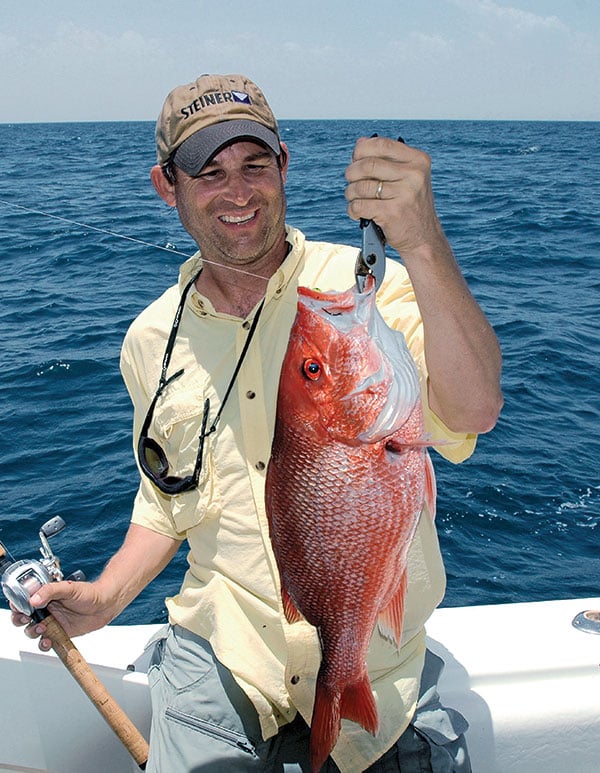
About 17 miles south of Orange Beach, Alabama, the captain idles his engines and intently fixes his gaze on the electronics screen in order to maneuver his vessel to just the right spot.
“We’re over the reef,” announces the captain. “Drop the bait straight down until you can’t see it any longer.”
The whole 6-inch menhaden, known locally as a pogie, steadily vanished into the relatively clear water of the Gulf of Mexico. The bait’s descent to the bottom came to an end when a 9-pound red snapper engulfed it only 10 feet from the surface.
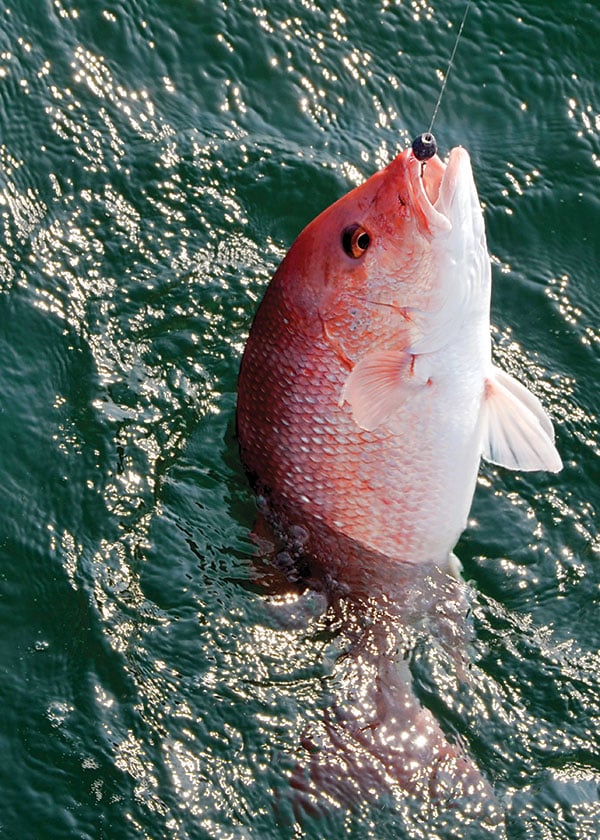
On the flying bridge, the captain yelled down: “Keep the fish in the water. Seven or eight much-bigger snapper are trying to get the bait out of the hooked one’s mouth. Put some more lines down there, quick.”
With only about 53 miles of coastline, the smallest on the Gulf Coast, Alabama still calls itself the Snapper Capital of the World. With catches of snapper up to 40 pounds, this moniker stands with good reason.
Alabama makes the most of its diminutive coastline with an abundance of artificial reefs. For many Alabama anglers, their annual offshore experience begins and ends with snapper season, which runs from June 1 to June 10 this year.
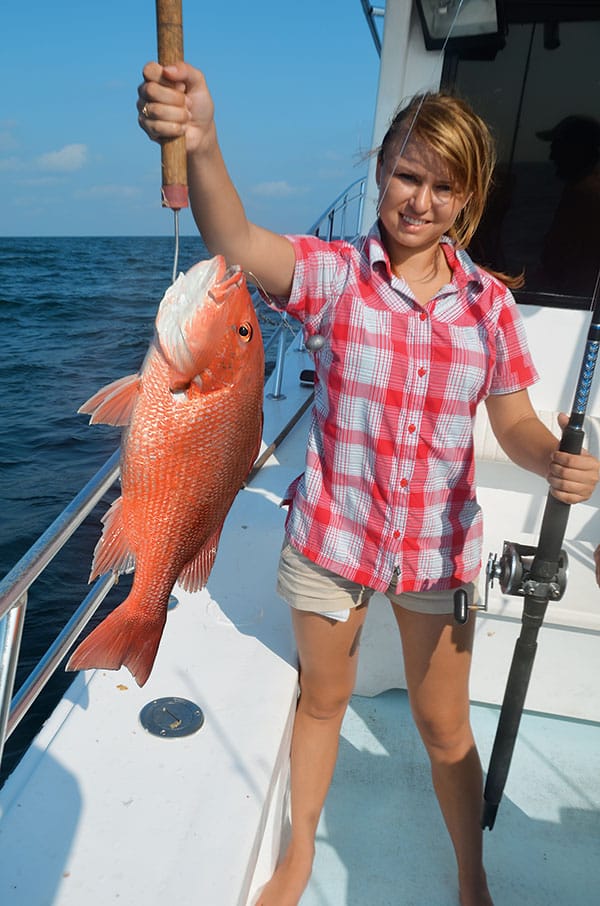
‘Bama Baits
“With as many snapper in the Gulf now, we don’t have to go very far to find fish,” says Capt. Mike Thierry of Capt. Mike’s Deep Sea Fishing based out of Dauphin Island, Alabama. “In the four decades I’ve been fishing for a living, I’ve never seen snapper fishing as good as it is now.”
Anglers usually start looking for snapper in 40 feet of water out to about 300 feet. These reef fish prefer to hang around hard structure, such as rocky reefs, oil platform supports, sunken ships and other cover where they can ambush bait. Over a good reef, most anglers simply send a juicy chunk of meat to the depths.
“For bait, I usually use either whole or butterflied menhaden,” explains Scooter Lang of Dauphin Island Adventure Charters. “Cigar minnows are also very good baits, as are whole squid. For live bait, I use pinfish or small fish we catch off the reefs. Live croaker is another really good bait. I use a 3- to 4-ounce egg sinker above a 3/0 to 4/0 barrel swivel on the main line. When fishing deeper than 80 feet or in strong current, I use a 6- to 10-ounce sinker. To the swivel, I’ll attach about a 4- to 8-foot leader with either a single circle hook or a tandem circle hook. For live bait, I use just one hook.”
To butterfly a baitfish, fillet both sides from the tail forward about halfway to the head, but leave the pieces attached to the body. When current hits the two slabs of flesh, they undulate and give the bait a lifelike appearance.
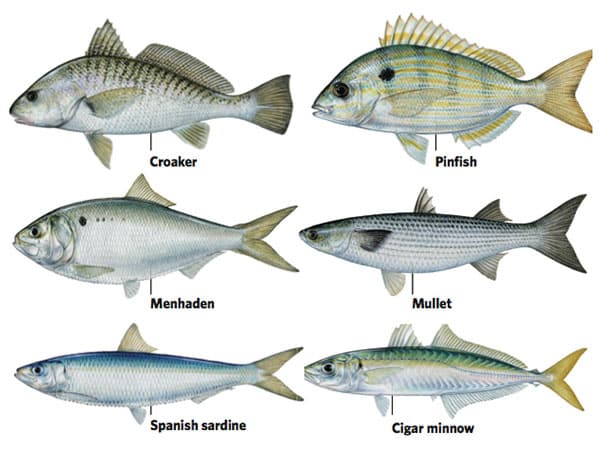
Tips for Big Reds
Send baits down slowly and thumb the reel to feed out line in 10-foot increments, pausing occasionally to determine the optimum depth. Over a good spot, anglers seldom wait long for bites, and frequently get bit as soon as their bait is out of sight. “The biggest snapper are higher in the water column,” explains Orange Beach captain Seth Wilson of Rip Tide Charters. “The bigger snapper don’t need bottom structure for safety. We use lighter weights and start from the top down rather than the bottom up. Snapper love things that are slowly falling, which more accurately simulates a naturally drifting bait.”
To keep big snapper near the surface and interested, many captains toss chum into the water. Some anglers put cut baitfish pieces in a bucket with holes drilled in the bottom, and hang it over the side to allow aromatic juices to ooze into the water. The fish chunks and juice create a chum slick that snapper find irresistible. The idea is to put just enough scent and temptation into the water to hold fish in the area without feeding them. When a chum slick forms, drop hooks baited with whole pogies, squid or fish chunks.
“We use a knocker rig with a 2-ounce weight that slides all the way to a 6/0 circle hook,” Wilson advises. “With a knocker rig, the weight slides down the line, but the bait goes up. When the sinker stops falling, the bait starts slowly sinking. The bait might be 20 to 30 feet above the sinker and slowly sinking like a bait in natural current. When we get a bite, we just tighten up the line.”
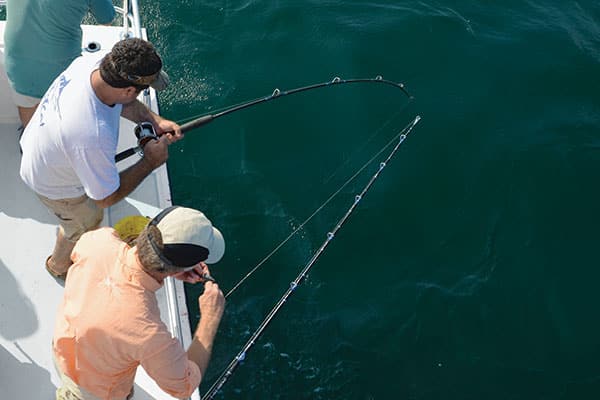
Artificial Reefs
To enhance fishing, Alabama created about 20,000 artificial reefs off the coast, many within easy range of small boats running out of Orange Beach, Gulf Shores or Dauphin Island. Depending on the location and depth, these reefs attract numerous red snapper as well as grouper, triggerfish, amberjack and various other roving predators.
“We don’t have to go far to find snapper,” Lang says. “I’ve been fishing a long time, and fishing off the Alabama coast now is 10 times better than it was in the 1970s or ’80s. We used to average about 5 pounds per fish, but now we’re up to about 8 pounds per fish. It’s not hard to catch a limit of 10-pounders. We can catch a 20-pound average off some reef modules.”
From Dauphin Island, many people fish scattered pyramid reefs or hundreds of army tanks. After Hurricane Frederick hit in 1979, the state scattered old bridge rubble from about 6 miles off the east end of Dauphin Island out to about 20 miles from the island. It sits in 60 to 76 feet of water. Many people start fishing here early in the season and then move to deeper water as the season progresses.
“About 90 percent of the time, we catch our snapper around artificial reefs,” recommends Jason Domangue of Movin’ On Up Charters on Dauphin Island. “We also catch a lot of fish around reefs that individuals put out. Normally, we fish from 80 to 200 feet deep for snapper. We usually go about 15 to 25 miles to find snapper, but at times, I might run as far out as 35 miles.”
Out of Orange Beach, many people fish the “trolling corridor,” a series of concrete pyramids that run to the Allen Liberty Ship Reef. It sits in about 56 to 83 feet of water. Another popular destination, the five Perdido Bridge Reefs, rubble from a bridge demolished by a hurricane, sit in about 80 feet of water 10 miles out from Orange Beach toward Pensacola. They hold concentrations of snapper and some amberjack.
As fuel prices soar and authorities clamp restrictions on offshore species, one might think it hardly worth the effort to venture into the Gulf just to reel in two red snapper during a brief season, but anglers can still load a boat and enjoy a great day on the water. For many Alabama snapper fishermen, these are the good ol’ days.









